Related Research Articles
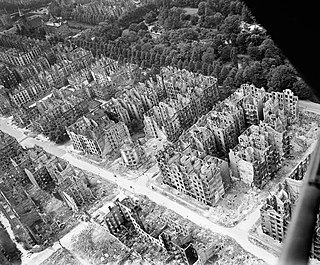
The Allied bombing of Hamburg during World War II included numerous attacks on civilians and civic infrastructure. As a large city and industrial centre, Hamburg's shipyards, U-boat pens, and the Hamburg-Harburg area oil refineries were attacked throughout the war.
Bomber Command is an organisational military unit, generally subordinate to the air force of a country. The best known were in Britain and the United States. A Bomber Command is generally used for strategic bombing, and is composed of bombers.
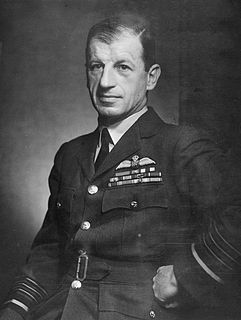
Marshal of the Royal Air Force Charles Frederick Algernon Portal, 1st Viscount Portal of Hungerford, was a senior Royal Air Force officer. He served as a bomber pilot in the First World War, and rose to become first a flight commander and then a squadron commander, flying light bombers on the Western Front.
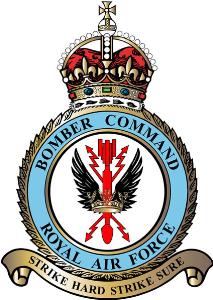
RAF Bomber Command controlled the Royal Air Force's bomber forces from 1936 to 1968. Along with the United States Army Air Forces, it played the central role in the strategic bombing of Germany in World War II. From 1942 onward, the British bombing campaign against Germany became less restrictive and increasingly targeted industrial sites and the civilian manpower base essential for German war production. In total 364,514 operational sorties were flown, 1,030,500 tons of bombs were dropped and 8,325 aircraft lost in action. Bomber Command crews also suffered a high casualty rate: 55,573 were killed out of a total of 125,000 aircrew, a 44.4% death rate. A further 8,403 men were wounded in action, and 9,838 became prisoners of war.

The Butt Report, released on 18 August 1941, was a report prepared during World War II, revealing the widespread failure of RAF Bomber Command aircraft to hit their targets.

The Pointblank directive authorised the initiation of Operation Pointblank, the code name for the part of the Allied Combined Bomber Offensive intended to cripple or destroy the German aircraft fighter strength, thus drawing it away from frontline operations and ensuring it would not be an obstacle to the invasion of Northwest Europe. The Pointblank directive of 14 June 1943 ordered RAF Bomber Command and the U.S. Eighth Air Force to bomb specific targets such as aircraft factories, and the order was confirmed when the Allies met at the Quebec Conference, 1943.
The Plan for Completion of [the] Combined Bomber Offensive was a strategic bombing recommendation made by HQ USSTAF for the Allies of World War II to target Axis petroleum/oil/lubrication (POL) targets prior to the Normandy Landings.
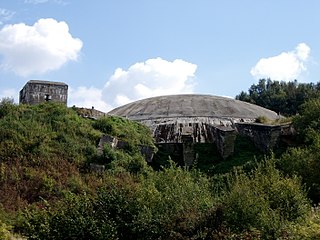
Crossbow was the code name in World War II for Anglo-American operations against the German long range reprisal weapons (V-weapons) programme. The main V-weapons were the V-1 flying bomb and V-2 rocket – these were launched against Britain from 1944 to 1945 and used against continental European targets as well.

The German city of Cologne was bombed in 262 separate air raids by the Allies during World War II, all by the Royal Air Force (RAF). A total of 34,711 long tons of bombs were dropped on the city by the RAF. 20,000 people died during the war in Cologne due to aerial bombardments.

The Area Bombing Directive was a directive from the wartime British Government's Air Ministry to the Royal Air Force, which ordered RAF Bomber Command to destroy Germany's industrial workforce and the morale of the German population, through bombing German cities and their civilian inhabitants.
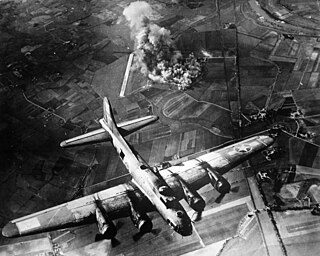
The Combined Bomber Offensive (CBO) was an Allied offensive of strategic bombing during World War II in Europe. The primary portion of the CBO was directed against Luftwaffe targets which was the highest priority from June 1943 to 1 April 1944. The subsequent highest priority campaigns were against V-weapon installations and petroleum, oil, and lubrication (POL) plants. Additional CBO targets included railyards and other transportation targets, particularly prior to the invasion of Normandy and, along with army equipment, in the final stages of the war in Europe.

Hans Jeschonnek was a German military aviator in the Luftstreitkräfte during World War I, a general staff officer in the Reichswehr in the inter–war period and Generaloberst (Colonel-General) and a Chief of the General Staff in the Luftwaffe, the aerial warfare branch of the Wehrmacht during World War II.

Professor Frederick Lindemann, Baron Cherwell, the British government's chief scientific adviser, sent on 30 March 1942 to British Prime Minister Winston Churchill a memorandum which, after it was accepted by the Cabinet, became known as the dehousing paper.

The Defence of the Reich is the name given to the strategic defensive aerial campaign fought by the Luftwaffe air arm of the combined Wehrmacht of Nazi Germany over German-occupied Europe and Nazi Germany during World War II. Its aim was to prevent the destruction of German civilians, military and civil industries by the Western Allies. The day and night air battles over Germany during the war involved thousands of aircraft, units and aerial engagements to counter the Allied strategic bombing campaign. The campaign was one of the longest in the history of aerial warfare and with the Battle of the Atlantic and the Allied Blockade of Germany was the longest of the war. The Luftwaffe fighter force defended the airspace of German-occupied territory against attack, first by RAF Bomber Command and then against the United States Army Air Forces (USAAF) in the Combined Bomber Offensive.

The Allied oil campaign of World War II pitted the RAF and the USAAF against facilities supplying Nazi Germany with petroleum, oil, and lubrication (POL) products. It formed part of the immense Allied strategic bombing effort during the war. The targets in Germany and in Axis-controlled Europe included refineries, synthetic-fuel factories, storage depots and other POL-infrastructure.
Operation Cockade was a series of deception operations designed to alleviate German pressure on Allied operations in Sicily and on the Soviets on the Eastern Front by feinting various attacks into Western Europe during World War II. The Allies hoped to use Cockade to force the Luftwaffe into a massive air battle with the Royal Air Force and U.S. Eighth Air Force to give the Allies air superiority over Western Europe. Cockade involved three deception operations: Operation Starkey, Operation Wadham, and Operation Tindall. Operation Starkey was set to occur in early September, Operation Tindall in mid-September, and Operation Wadham in late September 1943.
The oil campaign chronology of World War II lists bombing missions and related events regarding the petroleum/oil/lubrication (POL) facilities that supplied Nazi Germany or those Germany tried to capture in Operation Edelweiss.
The Mediterranean Air Command (MAC) was a World War II Allied air-force command that was active in the North African and Mediterranean Theater of Operations (MTO) between February 18 and December 10, 1943. MAC was under the command of Air Chief Marshal Sir Arthur Tedder, whose headquarters were next to those of the Supreme Allied Commander, General Dwight D. Eisenhower, in Algiers, Algeria, during the planning of the Allied campaigns in Tunisia, Pantelleria, Sicily, and the invasion of mainland Italy during the war.

The Air War Plans Division (AWPD) was an American military organization established to make long-term plans for war. Headed by Harold L. George, the unit was tasked in July 1941 to provide President Franklin D. Roosevelt with "overall production requirements required to defeat our potential enemies." The plans that were made at the AWPD eventually proved significant in the defeat of Nazi Germany.

Marshal of the Royal Air Force Sir Arthur Travers Harris, 1st Baronet,, commonly known as "Bomber" Harris by the press and often within the RAF as "Butch" Harris, was Air Officer Commanding-in-Chief (AOC-in-C) RAF Bomber Command during the height of the Anglo-American strategic bombing campaign against Nazi Germany in the Second World War.
References
- British Bombing Survey Unit (1998), Cox, Sebastian (ed.), The Strategic Air War Against Germany, 1939–1945: Report of the British Bombing Survey Unit (illustrated, reprint ed.), Psychology Press, p. 11, ISBN 978-0-7146-4722-7
- Churchill, Winston. The Second World War. Vol.5: Closing the Ring, Houghton Mifflin Books, 1986 ISBN 0-395-41059-2
- Harris, Arthur Travers; ed Cox, Sebastian (1995). Despatch on War Operations: 23 February 1942, to 8 May 1945, Routledge, ISBN 0-7146-4692-X.
- Harris, Arthur Travers (2005). Bomber Offensive, London: Pen & Sword Military Classics (first published 1947), ISBN 1-84415-210-3.
- United States Department of State / Foreign relations of the United States. The Conferences at Washington, 1941–1942, and Casablanca, 1943 (1941–1943). III. The Casablanca Conference, pp. 485–849